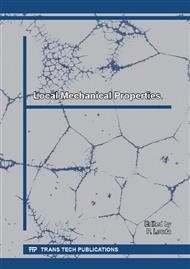p.64
p.69
p.73
p.77
p.82
p.86
p.91
p.95
p.99
Mechanical Properties of Al-Si Galvanic Coating and its Influence on Resistance Weldability of 22MnB5 Steel
Abstract:
Increase of quality and productivity in the same time are the most important in automotive industry. Use of high-strength steel 22MnB5 allows decrease of sheet metal thickness compared to standard steel. Commonly the steel 22MnB5 is welded with laser [1]. Use of this steel for spot resistance welding is not yet fully described. Steel 22MnB5 is coated with Al-Si galvanic coating for increasing high temperature oxidation resistance [2]. During hot stamping and subsequent heat treatment diffusion layer is created between coating and steel. The thickness of this layer is strongly dependent on temperature and time of heat process [3]. The paper deals with mechanical properties (chemical composition, indentation hardness) of this diffusion layer and Al-Si coating. Different thicknesses of diffusion layers were compared and its influence on weldability was described. Thin thicknesses have negligible effect on weldability, yet large thicknesses very negatively influence the weldability.
Info:
Periodical:
Pages:
82-85
Citation:
Online since:
July 2016
Authors:
Keywords:
Price:
Сopyright:
© 2016 Trans Tech Publications Ltd. All Rights Reserved
Share:
Citation:


